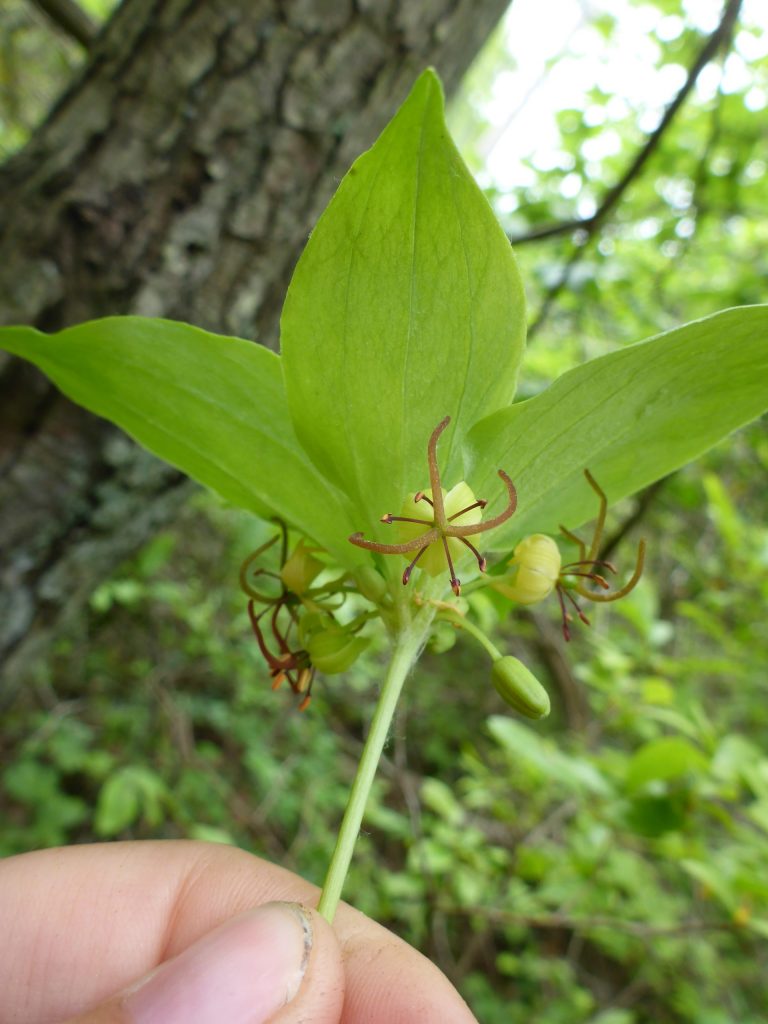Our first plot this week was arguably the easiest one we’ll visit all year.
It’s a nice to have a site like this every once and awhile, especially the way we’ve been fighting the weather this year. It is flat, rocky, and shaded by large canopy trees, significantly limiting the amount of little green stuff we have to walk through.
These “open” (AKA closed canopy) plots are nice for a couple of reasons. Not only do we get less beat up by understory vegetation (always a plus!), but we also work a lot faster because finding subplots is easier. We know roughly where the 11 survey spots are at each location, but sometimes finding them (and the stake that marks them!) is like finding a needle in a haystack.
 Our first plot of the week was rocky and open making for a couple of easy days!
Our first plot of the week was rocky and open making for a couple of easy days!
Because of the easy day, we managed to work ahead of schedule. We collected all of the vegetation data and canopy photos on Monday, and then wrapped up with soils on Tuesday. Rocky sites make for easy vegetation surveys, but tough soil days. After some adjustments—i.e. digging bigger holes—we managed to get through soil collection without working any extra hours. (Again—hats off to my kick-butt crew!).
Unfortunately, we were not as lucky Wednesday and Thursday. While we had really nice weather early in the week, Wednesday quickly turned cloudy and slightly soggy in the morning and it lasted through the afternoon. In addition to questionable weather, surveys were slow-going. What we gained in productivity because of an open plot on Monday and Tuesday we lost because of the dense understory of mountain laurel on Wednesday and Thursday.
 For our hiking pleasure on Wednesday and Thursday.
For our hiking pleasure on Wednesday and Thursday.
I would like to take this opportunity to declare that I (and probably most field techs) have a love-hate relationship with mountain laurel. I love her because she provides shelter, food, and nesting sites for wildlife. Her flowers are beautiful. She grows on acidic sites that most other plants can’t. She’s very impressive.
 Dense understories provide shelter and food for all kinds of wildlife, including these eastern towhee babies!
Dense understories provide shelter and food for all kinds of wildlife, including these eastern towhee babies!
But I hate mountain laurel because she is a big bully that beats me up for three months out of the year. She also hides a lot of holes, pits, rocks, snakes, and other things I usually trip over or nearly step on. She steals field equipment, including my field camera on Wednesday. And, like rocks, she makes soil sample collection difficult.
Thursday—even with the dense mountain laurel adding bruises to our bruises— we managed to find my camera (that in itself is incredible, folks!), and collect soils at 8 of the 11 subplots at the site. Unfortunately, we were unable to collect soil at the three remaining subplots because of a thunderstorm with 50-mph winds that hit around lunchtime. We took refuge in the truck to wait out the storm, which affected how much work we could get done before the end of the day.
 Collecting soils at the plot on Thursday.
Collecting soils at the plot on Thursday.
All-in-all, this summer has been extremely productive despite the weather. Better yet, we have seen an incredible amount of wildlife in the first three weeks!
This week? Two black bears, countless turkeys, several deer AND grouse (including little ones with mom!), and ground-nesting-birds galore. A constant reminder of just how important this job is, rain or shine!
This week’s featured deer-plate special!
Common Name: Indian cucumber-root
Scientific Name: Medeola virginiana
Description: A perennial herbaceous understory plant, and member of the lily family, that features a single whorl of 5 to 9 leaflets in non-flowering individuals and two stacked whorls of leaflets in flowering individuals—5 to 9 leaflets in the first tier and 3 to 5 leaflets in the second tier. Flowers bloom in late May to early June, becoming dark purple berries as the season progresses. Rhizomes (roots) are edible by humans, and taste like (you guessed it!)—cucumber!
 The Indian cucumber is to the right of the tree. Note the whorl of leaflets at the base and a second whorl higher up where flowers appear. This is a tall individual (~2.5).
The Indian cucumber is to the right of the tree. Note the whorl of leaflets at the base and a second whorl higher up where flowers appear. This is a tall individual (~2.5).
 Close-up of secondary stem and leaflets and flowers. Non-reproductive individuals will lack the secondary stem with flowers altogether.
Close-up of secondary stem and leaflets and flowers. Non-reproductive individuals will lack the secondary stem with flowers altogether.
Size: 2’’ to >3ft depending on site conditions, history of browsing (repeatedly browsed individuals are usually smaller), and reproductive status.
-Danielle Begley-Miller
Ph.D. graduate student
Department of Ecosystem Science and Management
PA Cooperative Fish & Wildlife Research Unit
